-
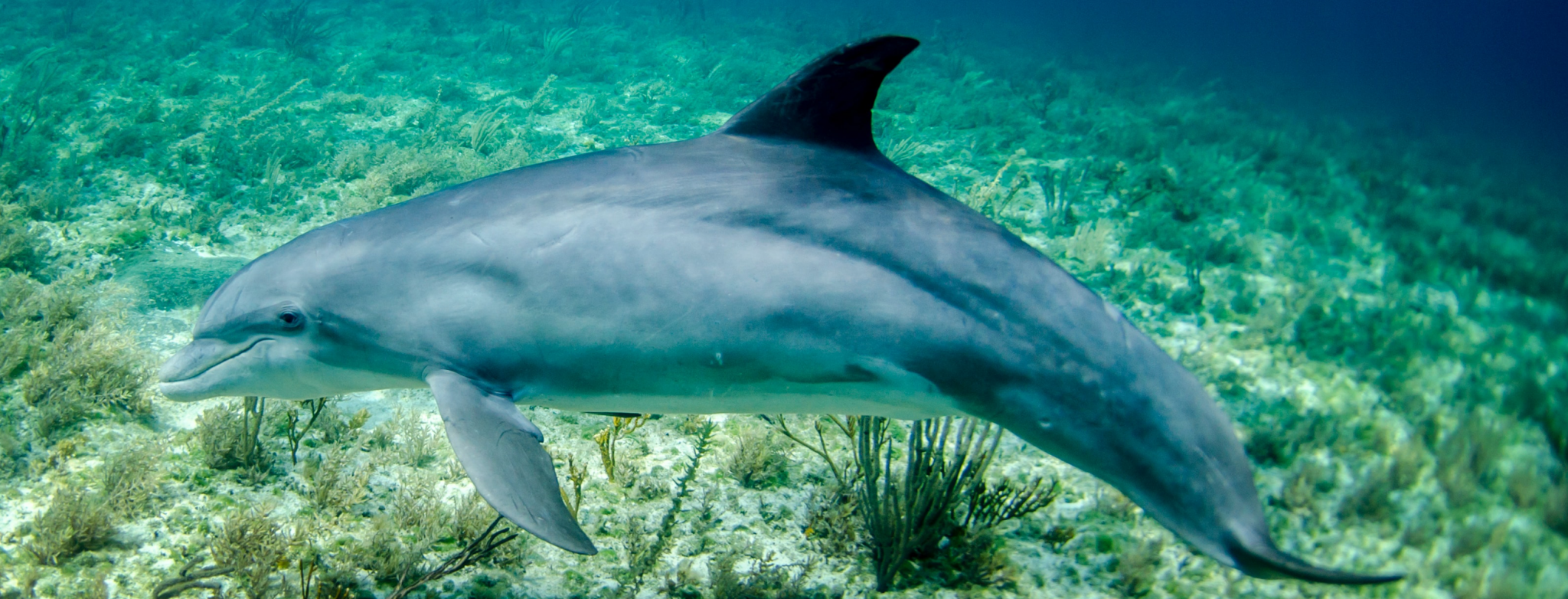 DOLPHINSGET INVOLVED
DOLPHINSGET INVOLVED
General Information about Dolphins
Dolphin Senses
Probably one of the most important differences between land mammals and dolphins is the way they vocalize.
Most mammals have a larynx or a similar structure that allows them to vocalize using throat vibrations and exhaled air. Dolphins and other cetaceans are no different, but they are specially adapted to make extremely high-pitched sounds used for echolocation, as well as more human-pitched sounds used for ordinary communication with others in their pod.
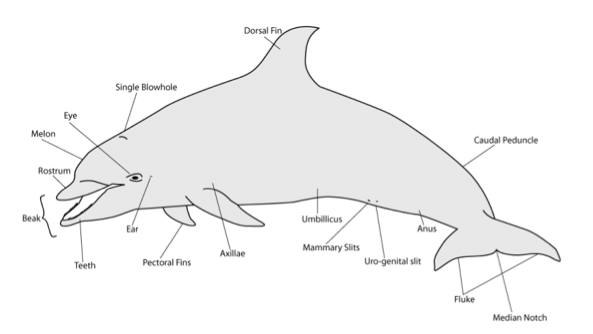
In addition, dolphins have extremely sharp hearing, and much better vision than one might expect of an animal that uses echolocation as its primary means of sensing the world. Dolphins can see limited colors, and even have limited binocular vision like a primate. They do not possess much of a sense of smell, however.
Dolphin Movement - Swimming and Jumping
One of the most interesting differences between cetaceans and fish is their swimming method. Fish swim by wiggling left and right, and if you watch crocodiles and snakes, you will see the same motion. But because dolphins are descendants of land-living mammals with a very different skeletal structure, they use up and down strokes to swim.
Today you can still see some of the remnants of terrestrial mammals in the dolphin’s skeletal structure. For instance, they have forelimbs, but they are adapted into flippers with shortened arm bones and no fingers. Hind limbs can sometimes be found as vestigial skeletal, much like tails can still be found vestigial on some humans. Most cetaceans, including dolphins, still have a pelvis, which is entirely absent in fish.
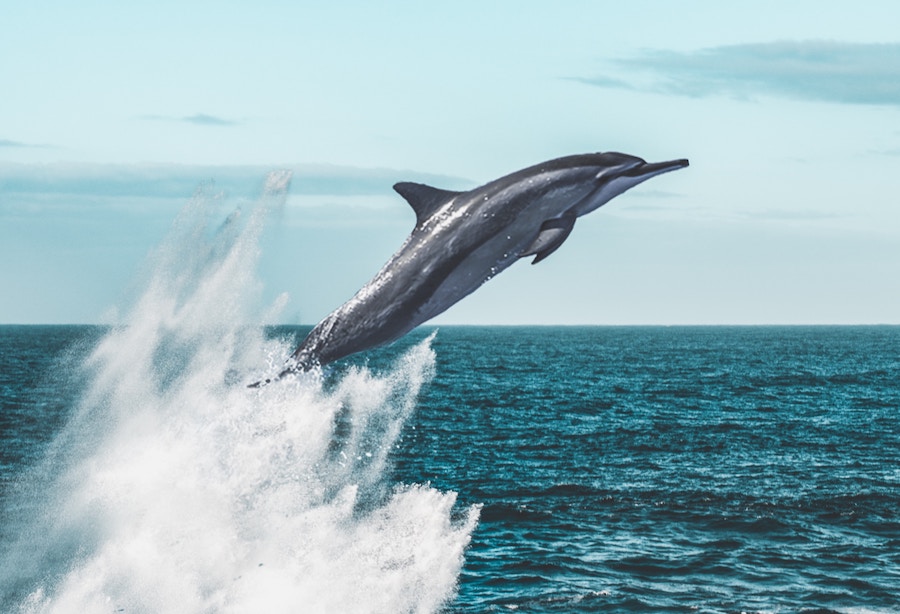
Unlike other mammals, a dolphin’s hindquarters are much more developed than its front muscles; the flippers are only to steer, while the tail provides most of the force of motion. Dolphins have also developed horizontal flukes on their tail to make propulsion more efficient, and they have developed a dorsal fin just like fish. External parts that get in the way of a dolphin’s streamlined shape, like the genitalia or the ears, have been entirely lost, turning into internal organs instead.
There is an on-going debate about why dolphins jump out of the water, and scientists have different views of this behaviour. Some think that dolphins jump while travelling to save energy, as going through the air consumes less energy than going through the water. Others think that jumping gives a better view of distant things, mainly food, so they jump to locate food or food-related activity, like seagulls eating or pelicans hunting. Other explanations suggest that dolphins use jumping to communicate either with a mate or with another pod. Some people also think that dolphins jump for cleaning, trying to get rid of parasites while jumping. Equally, some scientists believe that the dolphins want to have good fun, as playing helps to keep senses in their best form… and why not?
Dolphin Breathing
Dolphins, like other mammals, breathe air instead of water and thus use lungs instead of gills. A dolphin that cannot surface also cannot breathe, and thus will drown. This is why dolphins caught in fishing nets have such a poor chance of survival. Unlike most fish, dolphins are very much creatures of the surface of the ocean.
Like whales and other cetaceans, dolphins respire through a blowhole at the top of their heads, breathing in air when they break the surface of the water. Unlike humans, dolphins do not breathe reflexively; instead, they have to remember to breathe. An unconscious dolphin is likely to be a dead dolphin. When actively swimming, dolphins must breathe fairly often. However, dolphins can hold their breath for fifteen minutes or more.
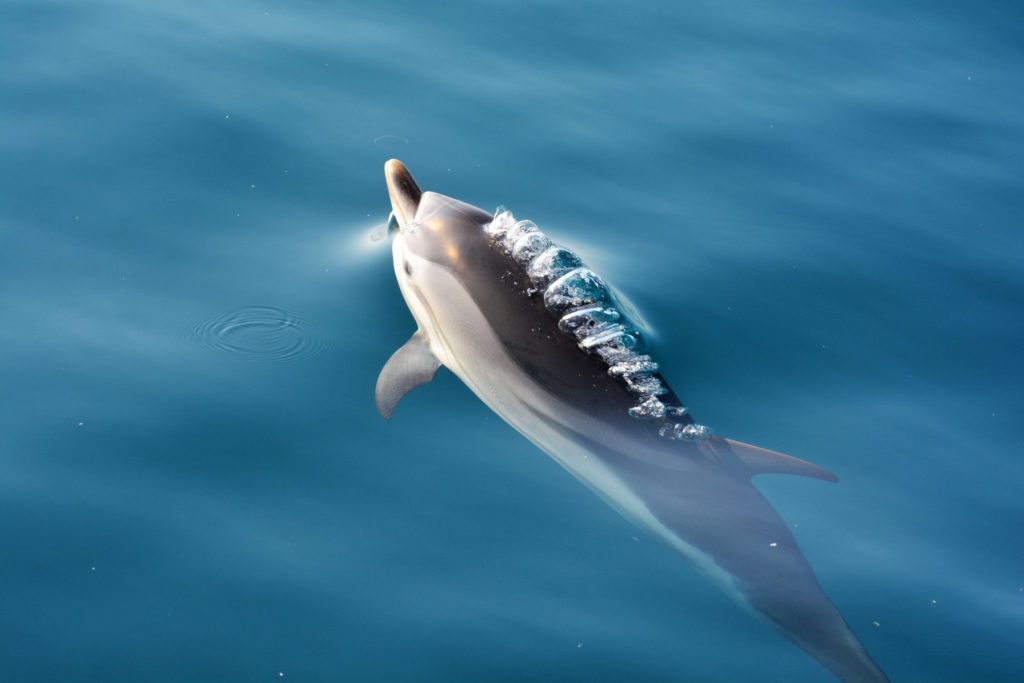
Dolphin Intelligence
Dolphins are famous for being highly intelligent creatures, perhaps amongst the most intelligent of all living species. So far, most scientists have refused to take a firm stand on the intelligence level of dolphins. The biggest problem researchers are running into seems to be the actual definition of intelligence and the way it can be tested in animals.
Darwin’s theory bases intelligence on the ability of a species to recognize what it needs to survive, while other schools of thought see the size and architecture of the brain, the ability to communicate, or the ability to exhibit playfulness as more relevant indicators.
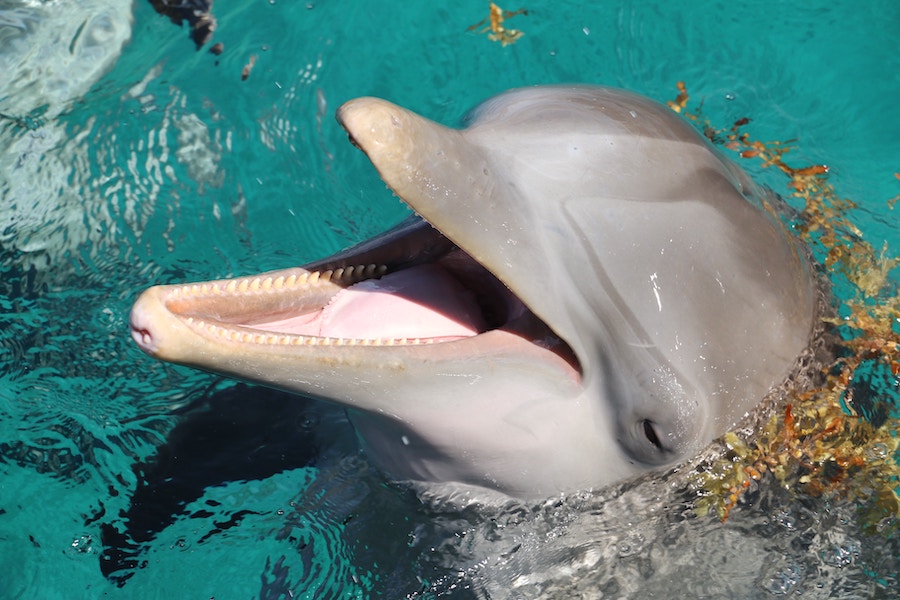
Another reason that the research on dolphin intelligence is limited, is that it is difficult and expensive to do in the wild. Dolphins in captivity may respond differently based on their surroundings and, therefore may not be representative of the wild dolphin. The U.S. Navy has carried out extensive research on dolphins and even trained them to search and tag mines. However, that information has not been released to the public.
While most of us outside the scientific realm know that dolphins do communicate with each other and that they are one of the most playful animals in the world, we have never been exposed to the intricacies of the dolphin’s brain. Dolphins have two hemispheres, just like humans. However, theirs are split into four lobes instead of three. The fourth lobe in the dolphin’s brain actually hosts all of the senses, whereas, in a human, the senses are split. Some believe that having all of the senses in one lobe allows the dolphin to make immediate and often complicated judgments that are well beyond the scope of human ability.
When studying the neo-cortex, which is the outside surface of the brain that is responsible for forming perceptions, memories and thoughts, dolphins have more convolution than the most intelligent humans. It is thought that dolphins may also be able to use the hemispheres of their brain separately, as they have separate blood supplies – which is something exclusive to the dolphin. To add more weight to this supposition, dolphins can also move their eyes independently, which has led some researchers to suggest that dolphins are actually able to sleep with one side of their brain at a time.
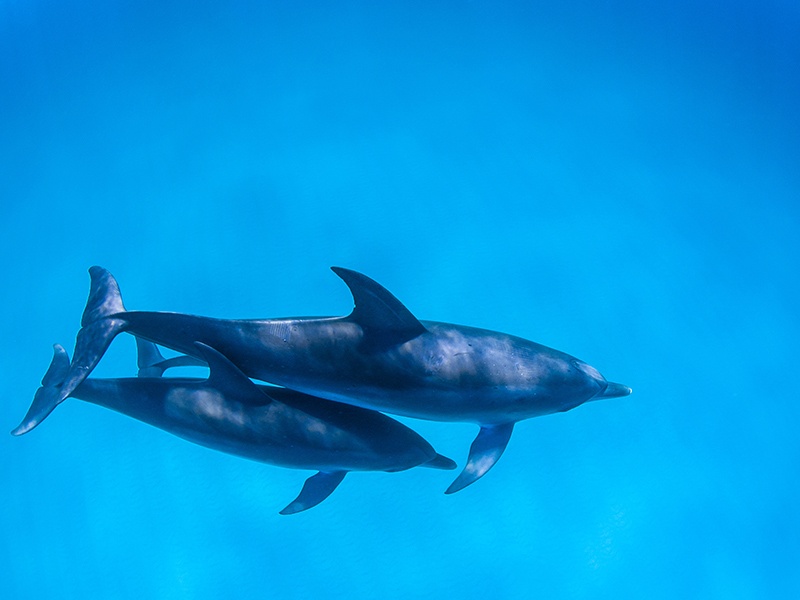
Some researchers have suggested that the size and complexity of the brain at birth is a better measure of intelligence. If that research holds up, however, once more the dolphin comes out on top. The Bottlenose dolphin has a brain mass at birth that is 42.5% of that of an adult human’s brain mass. At birth, human brain only has 25% of its fully grown mass. At 18 months, the brain mass of the Bottlenose corresponds to 80% of that of an adult human, who doesn’t usually achieve this level until the age of three or four.
While the research obtained certainly makes it look like the dolphin may be the closest to our level of intelligence, it may be quite some time before it is actually proven. Until then, their true capabilities will remain a mystery.
Although we have been fascinated by these animals for thousands of years, it wasn’t until approximately the 1940s that research in the field of marine mammals really began. The US Navy are the renowned experts in this field and have been using dolphins in their military teams since the 1960s.
Communication and Language
Dolphins are almost constantly making sounds of one of two kinds: communicative or navigational. The different sounds are made in different ways.
Echolocation sounds are produced in their nasal passages just below their blowholes, and are called clicks. Clicks are sometimes produced in such rapid succession that they sound like buzzes or even quacks, and beamed forward from the dolphin’s head. These sounds are produced just behind the melon, an oily, slightly off-center lump on what you would call the dolphin’s forehead, and the sound waves are focused forward through it.
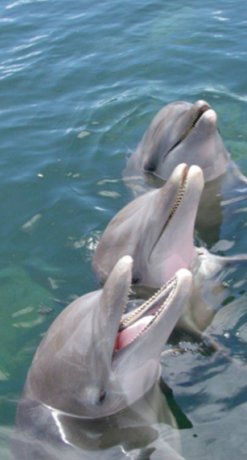
Scientists are not entirely certain how the melon works, but it does seem to amplify and clarify the dolphin’s echolocation sounds and may play a part in collecting the sounds bouncing back. They allow a dolphin to detect remarkably detailed information from the world around them. In one test, a dolphin found a marble-sized sphere at more than the length of a football field. Some scientists speculate that echolocation sounds may also be used to deliver an acoustic shock to small prey.
In the larynx, dolphins can produce high-pitched whistles and squeals, which can rapidly change pitch. Whistles are single tones, with no vibrations that make them sound like buzzes. As far as scientists can tell, the whistles are a form of communication with other dolphins, and squeals are used to express alarm or sexual excitement.
There have been vast studies done on whether dolphins communicate with language, some more reliable than others. Even major researchers have made some pretty far-fetched claims with little scientific data supporting their claims. On the other end, fisheries and others who depend on the deaths of dolphins to support their livelihoods tend to downplay the communication and intelligence of dolphins, sometimes equating them with fish.
The truth, as in almost every case with extreme opposing claims, lies somewhere in the middle. Dolphins are highly intelligent and have a greater brain-to-body-weight ratio (important in determining real intelligence) than any other mammal besides man. They have brain ratios twice the size of any of the great apes and are estimated to fall in approximately the same category as australopithecines, early humanoid ancestors. The appearance of the dolphin brain is also startlingly similar to that of a human brain.
Like most other animals, dolphins do have communication. Their squeals and whistles communicate emotional states and, often, the presence of danger and food in the area. They may also help them coordinate “herding” processes. Dolphin females often act as “midwives” to new mothers, and every dolphin in the pod cares for the others.
But there is some evidence that dolphins communicate linguistically. Dolphins tend to stay within their own pods and may have trouble understanding “foreign” dolphins. In studies done on dolphins near Scotland, individuals appear to have names; or at least, other dolphins use specific and unique whistles only in the presence of certain other dolphins, as if calling them by name.
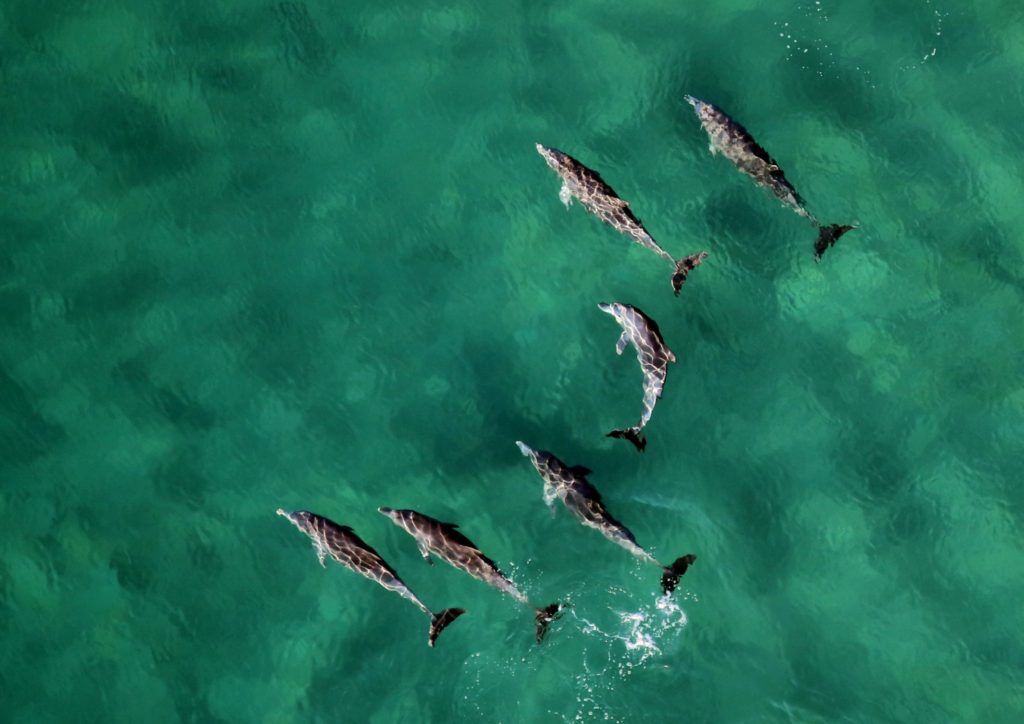
Unlike any other animal besides humans, dolphins exhibit a great tendency to take turns when vocalising – making their communications sound like a conversation. There have also been very basic linguistic studies of dolphin sound patterns. According to some studies, dolphin sounds follow the same basic patterns of all human-based language, from Morse code to Chinese. Though we cannot understand what they are saying, it seems conceivable that dolphins may indeed have language, though it’s certainly a language unlike any we know today.
Pods of dolphins in the English Channel stay on their own side – the French-water dolphins on the France side and the English-water dolphins on the England side – even though they are of exactly the same species and might be expected to mingle more. Some researchers say that this indicates not just language, but that two groups have developed a distinct language that can’t be understood by the others.
Whether it is true or not, there is a lot of research on dolphin vocabulary that indicates they communicate with at least as much sophistication as the higher apes. They have a vocabulary of danger sounds, food sounds, and seeking sounds, and sometimes put these sounds together in a reasonably complex fashion. There is also evidence that they may greet one another by name; specific sounds are only uttered when meeting certain dolphins.
Dolphin Relationships
Dolphins are social animals, living in groups called pods and taking loving care of their babies. They’re also known to be very friendly to humans.
Many researchers agree that dolphins are very sociable creatures and need interaction with each other while hunting, mating and defending themselves and their pods. Typically, dolphins live and travel in groups ranging from 2-40 dolphins, but dolphin pods as large as several hundred members have been identified.
These groups are actually called herds or schools. In some cases, these larger groups have been to known to include more than one species that seem to interact well together.
The species that usually associate in this multi-species group are the Spinner and the Spotted Dolphins. As the feeding habits of these two species are quite the opposite, they are able to travel together without competing for food.
Lasting Relationships
Most experts believe that the social relationships formed by dolphins are actually long-lasting, and it has been reported that when dolphins meet other pods or groups, they often engage in a sort of greeting ceremony that suggests they are renewing old relationships.
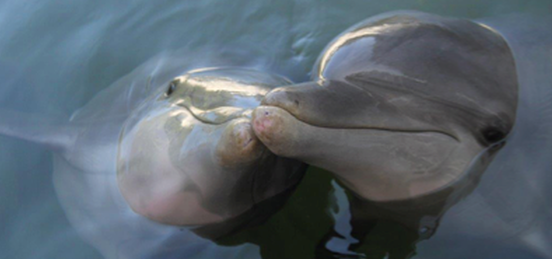
While large groups of dolphins usually have a varied mix of age and sex, the smaller pods tend to be made up of either a single adult or a group of (male or female), a group of females and their young or a group of adult and young males. Males are dominant in all groups, but there is no evidence of strong social bonds between males and females.
A common example of social interaction and high intelligence is the constant play in which dolphins seem to engage. Scientists report that juvenile and adult dolphins often chase each other and toss items such as seaweed back and forth.
Day to day Relationships
Dolphins often have close body contact with other dolphins through rubbing, petting, and even hitting each other. Dolphins often swim extremely close to each other, often resting fins on the other dolphin. Scientists believe this behaviour actually indicates a close friendship. Dolphins also have been watched rubbing pectoral fins as if this was a handshake.
Another way that scientists identify social interactions between dolphins is by their behaviour. When aggressive, dolphins tend to approach from a direct or perpendicular line. When the approach is non-threatening, a dolphin usually comes from behind or in an oblique angle.
Dolphin Echolocation and Sonar
It is believed that dolphin echolocation is the result of evolution over time. This process allows them to send out sound waves that are like a click. When those sounds hit an object, it bounces back vibrations to the dolphins. This allows them to identify where objects are located. It also gives them information about the location of the object and some indication of the shape and size of it.
The amount of time it takes for the sound waves to come back helps the dolphins to identify the distance. The longer it takes for the sound waves to return, the more distance between them and that given object. Many experts have long looked into echolocation, but there is still plenty that is unknown about it. The first person to look at it closely and to document the findings was Jacques-Yves Cousteau. He wrote about it in a book published in 1953, called The Silent World.
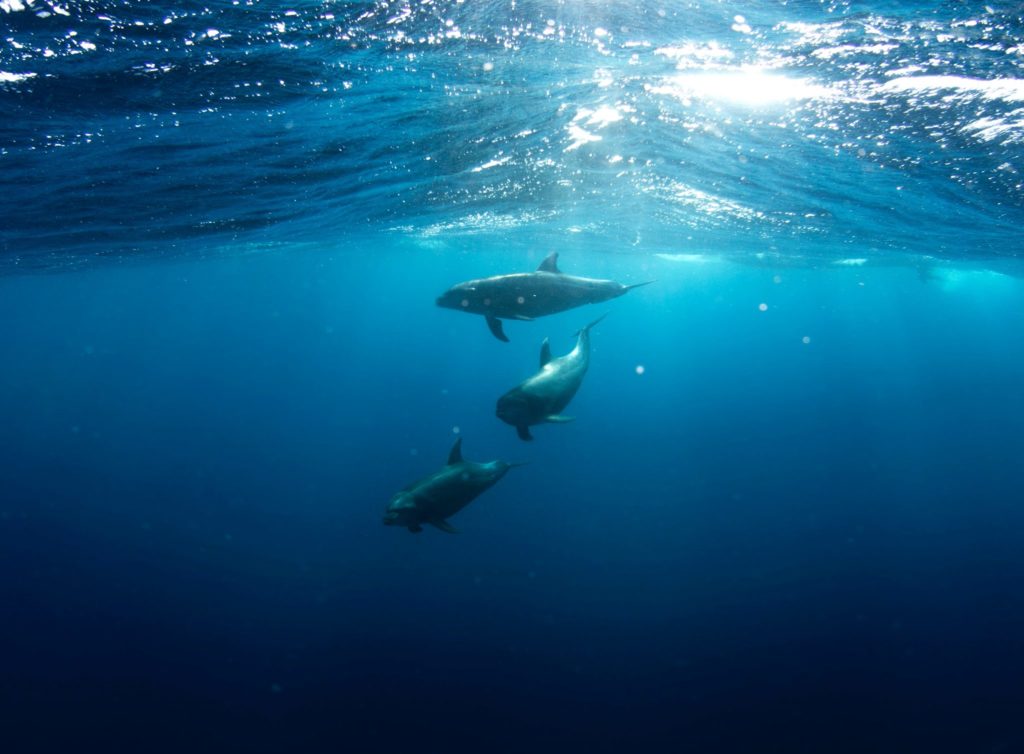
Some humans say that they can actually feel the buzz from the dolphin echolocation when they are in the water around them. They can’t hear it, but they do feel it, and that is a very interesting feeling to identify and address. It is also a huge mystery, and one more part of this process that has the experts mystified.
Dolphins make a sound that travels quickly through the water. This sound bounces back, and the information is decoded in the Dolphin Melon.
What is known is that dolphins have the ability through echolocation to have a sound frequency of 120 kHz, while for humans with excellent hearing, it is about 20 kHz. Even though dogs and cats have better hearing than people, it still doesn’t compare to the dolphin. Dogs have about 45 kHz, and cats have about 65 kHz.
Dolphins have a melon in the head that allows for the information to be transmitted. The transmitter for it is found in the lower jaw, and the teeth of dolphins work like antennas to send the signals. It is a very complex element of their survival and their anatomy that has many experts in awe.
It is believed that the whistling sounds dolphins are known to make also are part of echolocation. They are able to pass air through the blowhole through air sacs. If you take a balloon, partially blow it up, and then slowly let out air, this is similar to the same results they get. Behind and below the blowhole is a bi-sonar signal generator. The vibrations here against the blowhole is what allows echolocation to be initiated. They are referred to as the echolocation pulse.
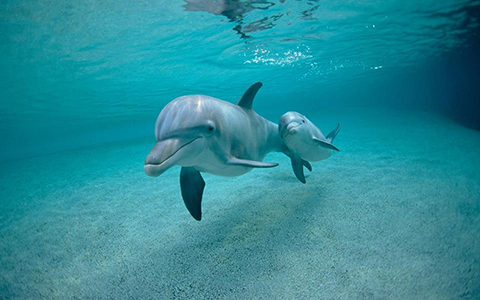
The lower jaw plays a role in all of this. It is filled with fat and, for the dolphin, plays the same role as the outer part of human ears do. This is how they can figure out the direction from which a given sound is coming. It is also important to point out that sound can travel 4 ½ times faster in the water than out of it.
The high-frequency sounds don’t travel very far in the water. Low-frequency sounds have more energy so they can travel a greater distance. Most of the time, dolphins will get the best results with echolocation when the object is from 16 feet to 656 feet from them.
A common question then is if dolphins have such good hearing through echolocation, why do they often collide with boats and other vehicles in the water? There has been plenty of research about this, and the problem isn’t with the dolphins. Instead, it stems from the fact that there are plenty of negative environmental concerns out there with which they have to contend. They can include sonar testing, offshore drilling, commercial fishing activities, and more.
The result of such noise in the environment for dolphins is upsetting. It can cause them to lose their hearing over time. It can also result in them becoming disoriented and not be able to successfully navigate through the water for migration and other purposes. In the most severe cases, dolphins have died due to haemorrhaging inside of the ear. This is concerning for the future of dolphins, and some conservation efforts in motion address these issues.
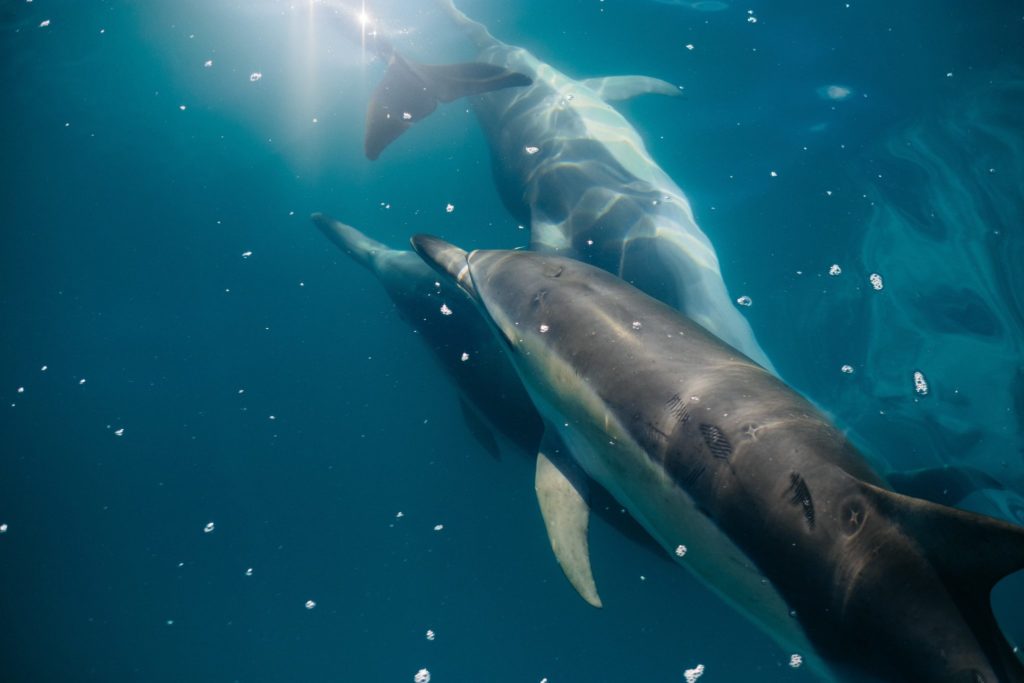
Sometimes, you may also hear echolocation referred to as bi-sonar. There are quite a few animals out there that use it to help them find out what is going on in their environment based on the echoes that return. However, it is believed that the dolphin has one of the most advanced and sophisticated systems.
Dolphins are incredibly good at distinguishing their own echolocation sonar even in very noisy underwater environments – and in fact are very good at locating the drift nets that entangle and kill so many of them, raising the question of why they are still often trapped in them. It has also been found, though, that some noisy locations confuse dolphins, perhaps explaining why dolphins often ground themselves in areas where Navy ships using active sonar are performing manoeuvres. Could the clumsier man-made sonar be using frequencies the dolphins associate with something else? Or perhaps it’s like looking into a strobe light for them. Whatever the explanation, the Navy is interested in eradicating the problem.
Dolphin Feeding
Dolphins spend plenty of time finding food daily. They can consume up to 13 kilos of fish per day as adults.They can use a variety of different feeding techniques that have proven to help them in a variety of settings. In addition to dining on fish, squid is popular.
Experts believe that the process of migrating is often connected with finding enough food. Dolphins will move long distances in order to find enough food at various times. If they have enough food though where they reside and the temperature of the water is also acceptable, they do not migrate.
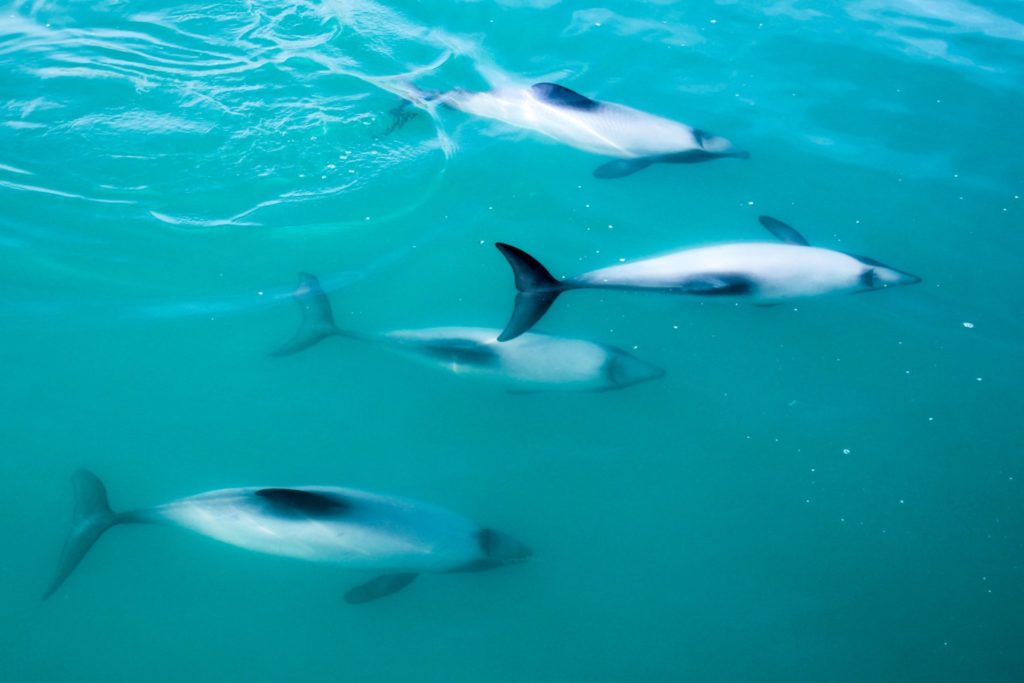
Herding is one of the most common methods of feeding that the dolphins use. It involves a pod working as a unit to get the school of fish to curl up into a tight ball. Then the dolphins will take turns to rush though and ploy the center of that ball, eating all they can in the process. The fish are stunned, so they are easier to get this way.
There are certain species of dolphins that will use their flukes too in order to stun their prey. They will hit them hard, and then while they are still disoriented, they will feed on them. What is also very interesting is that, in some locations, the dolphins have learned behavior to help the fishermen drive the fish into their nets. The payoff for the dolphins is that they get to feed on the leftover fish that get out of the nets.
There are those dolphins that do take part in individualized hunting. They may be in small subgroups too of just a few dolphins. They have to move in various directions in order to make sure they can get food. It looks uncoordinated and unorganized. Sometimes, random feeding also occurs with such chaos.
However, most of the time, group random feeding does have some direction to it. There are several subgroups of individuals, and they create a very cohesive overall strategy to get the food with ease. By going in opposite directions, the prey can become confused and has very little chance of escaping.
The concept of front cooperative feeding involves driving the schools of fish to the shallow areas of the water. Fish can be driven to the coast, to some barrier, or even a subgroup of the dolphins. Circular cooperative feeding has been observed with the larger pods of dolphins. They divide into subgroups and then form circles and take part in rapid diving. They will surround schools of fish this way and continue to reduce the overall size of that circle before they take part in consuming what they have surrounded.
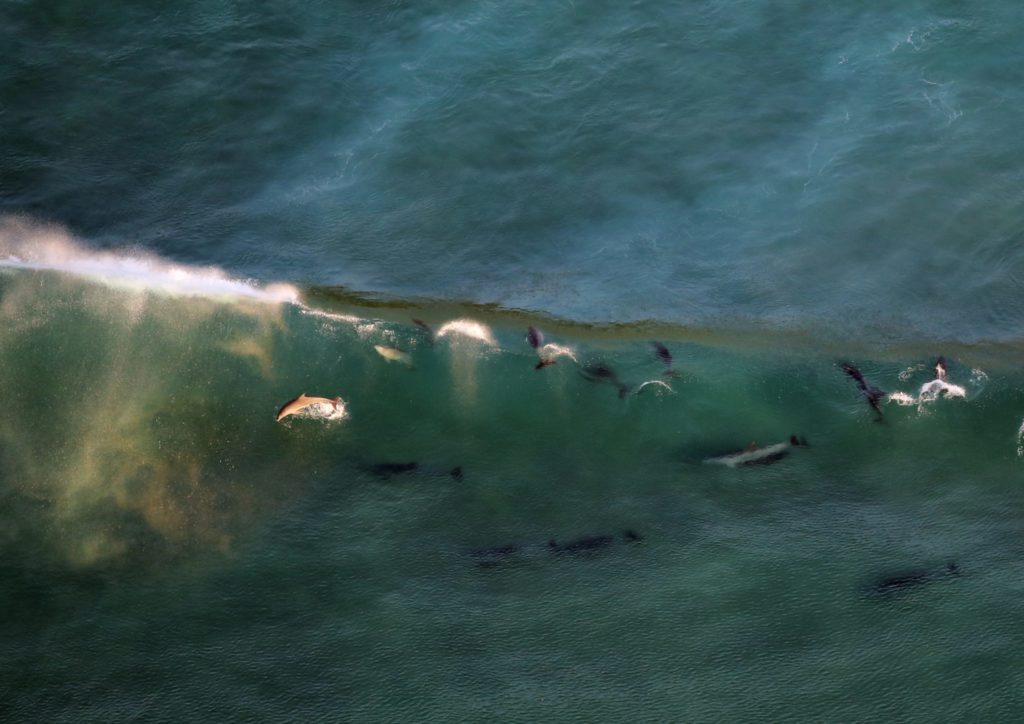
Something very similar is the cooperative crossing feeding. It involves the dolphins moving in a cross pattern with groups of them swimming in different directions. This allows the fish to be in the middle of the routes that the dolphins have created. Such a strategy usually is a good one to use around the rocky shores and in the shallow areas of small bays.
The use of zigzag cooperative feeding is more strategic, but it can help to get the food with less energy by the dolphins. This type of feeding effort is not seen very often, though. It usually occurs with very cohesive movements with the dolphins all moving in the same direction and then quickly switching and moving back the other way with a distance of about 100 meters for the zigzag pattern.
Dolphins are very intelligent, so they have the option to create different methods that fit their feeding needs. They have been seen mixing two or more of the mentioned feeding strategies into one session to get results.
The ability to create such variations with ease and to create new formations is very interesting to observe. The level of cooperation it takes among the dolphins in the pod is also noted.
Some behavior seems to be more evident in a given pod than others when it comes to feeding. Part of this stems from the strategies that they have learned work very well in that given location. However, it is also the result of the older dolphins teaching these feeding methods to the newer members of the pod over time.
Dolphins do not use their teeth to eat – they use their set of 100 teeth to grasp food. Their meals are swallowed whole, so the prey must not be too large. Like cows, they have two stomachs. The first one stores food, which then moves to the second stomach, where the digestion to take place.
